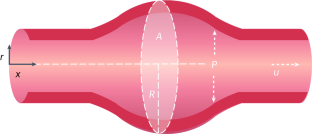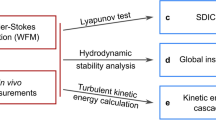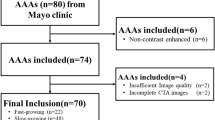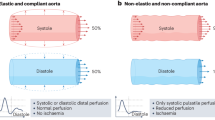Abstract
The diagnosis of aneurysms is informed by empirically tracking their size and growth rate. Here, by analysing the growth of aortic aneurysms from first principles via linear stability analysis of flow through an elastic blood vessel, we show that abnormal aortic dilatation is associated with a transition from stable flow to unstable aortic fluttering. This transition to instability can be described by the critical threshold for a dimensionless number that depends on blood pressure, the size of the aorta, and the shear stress and stiffness of the aortic wall. By analysing data from four-dimensional flow magnetic resonance imaging for 117 patients who had undergone cardiothoracic imaging and for 100 healthy volunteers, we show that the dimensionless number is a physiomarker for the growth of thoracic ascending aortic aneurysms and that it can be used to accurately discriminate abnormal versus natural growth. Further characterization of the transition to blood–wall fluttering instability may aid the understanding of the mechanisms underlying aneurysm progression in patients.
This is a preview of subscription content, access via your institution
Access options
Access Nature and 54 other Nature Portfolio journals
Get Nature+, our best-value online-access subscription
$29.99 / 30 days
cancel any time
Subscribe to this journal
Receive 12 digital issues and online access to articles
$99.00 per year
only $8.25 per issue
Buy this article
- Purchase on Springer Link
- Instant access to full article PDF
Prices may be subject to local taxes which are calculated during checkout




Similar content being viewed by others
Data availability
The main data supporting the findings of this study are available within the paper and its Supplementary Information. The raw clinical data in the study are too large to be publicly shared, yet they are available for research purposes from co-author M.M. on reasonable request.
Code availability
Codes for the collection and analysis of data are available on request.
References
Jersey, A. M. & Foster, D. M. Cerebral Aneurysm (Northwell Health, 2020).
Laukka, D. et al. Prevalence of thoracic aortic aneurysms and dilatations in patients with intracranial aneurysms. J. Vasc. Surg. 70, 1801–1808 (2019).
Li, X., Zhao, G., Zhang, J., Duan, Z. & Xin, S. Prevalence and trends of the abdominal aortic aneurysms epidemic in general population—a meta-analysis. PLoS ONE 8, e81260 (2013).
Johansson, G., Markström, U. & Swedenborg, J. Ruptured thoracic aortic aneurysms: a study of incidence and mortality rates. J. Vasc. Surg. 21, 985–988 (1995).
Gawenda, M. & Brunkwall, J. Ruptured abdominal aortic aneurysm: the state of play. Dtsch. Arztebl. Int. 109, 727–732 (2012).
Kuzmik, G. A., Sang, A. X. & Elefteriades, J. A. Natural history of thoracic aortic aneurysms. J. Vasc. Surg. 56, 565–571 (2012).
Coady, M. A., Rizzo, J. A., Hammond, G. L., Kopf, G. S. & Elefteriades, J. A. Surgical intervention criteria for thoracic aortic aneurysms: a study of growth rates and complications. Ann. Thorac. Surg. 67, 1922–1926 (1999).
MA3RS Study Investigators. Aortic wall inflammation predicts abdominal aortic aneurysm expansion, rupture, and need for surgical repair. Circulation 136, 787–797 (2017).
Wilson, K. et al. Relationship between abdominal aortic aneurysm wall compliance and clinical outcome: a preliminary analysis. Eur. J. Vasc. Endovasc. Surg. 15, 472–477 (1998).
Wilson, K. A. et al. The relationship between abdominal aortic aneurysm distensibility and serum markers of elastin and collagen metabolism. Eur. J. Vasc. Endovasc. Surg. 21, 175–178 (2001).
Wilson, K. A. et al. The relationship between aortic wall distensibility and rupture of infrarenal abdominal aortic aneurysm. J. Vasc. Surg. 37, 112–117 (2003).
Niestrawska, J. A. et al. The role of tissue remodeling in mechanics and pathogenesis of abdominal aortic aneurysms. Acta Biomater. 88, 149–161 (2019).
Mulè, G. et al. in The Relationship Between Aortic Root Size and Hypertension: An Unsolved Conundrum (ed. Islam, M. S.) 427–445 (Springer, 2017).
Staarmann, B., Smith, M. & Prestigiacomo, C. J. Shear stress and aneurysms: a review. Neurosurg. Focus 47, E2 (2019).
Geisbüsch, S. et al. A prospective study of growth and rupture risk of small-to-moderate size ascending aortic aneurysms. J. Thorac. Cardiovasc. Surg. 147, 68–74 (2014).
Chandrashekar, A. et al. Prediction of abdominal aortic aneurysm growth using geometric assessment of computerized tomography images acquired during the aneurysm surveillance period. Ann. Surg. https://doi.org/10.1097/sla.0000000000004711 (2020).
Hirata, K. et al. Machine learning to predict the rapid growth of small abdominal aortic aneurysm. J. Comput. Assist. Tomogr. 44, 37–42 (2020).
Tsigklifis, K. & Lucey, A. D. Asymptotic stability and transient growth in pulsatile poiseuille flow through a compliant channel. J. Fluid Mech. 820, 370–399 (2017).
Davies, C. & Carpenter, P. W. Numerical simulation of the evolution of Tollmien–Schlichting waves over finite compliant panels. J. Fluid Mech. 335, 361–392 (1997).
Davies, C. & Carpenter, P. W. Instabilities in a plane channel flow between compliant walls. J. Fluid Mech. 352, 205–243 (1997).
Pitman, M. W. & Lucey, A. D. On the direct determination of the eigenmodes of finite flow–structure systems. Proc. R. Soc. A 465, 257–281 (2009).
Azer, K. & Peskin, C. S. A one-dimensional model of blood flow in arteries with friction and convection based on the womersley velocity profile. Cardiovasc. Eng. 7, 51–73 (2007).
Wang, X.-F. et al. Fluid friction and wall viscosity of the 1d blood flow model. J. Biomech. 49, 565–571 (2016).
Womersley, J. R. Method for the calculation of velocity, rate of flow and viscous drag in arteries when the pressure gradient is known. J. Physiol. 127, 553–563 (1955).
Raines, J. K., Jaffrin, M. Y. & Shapiro, A. H. A computer simulation of arterial dynamics in the human leg. J. Biomech. 7, 77–91 (1974).
Huang, J. et al. Comparison of dynamic changes in aortic diameter during the cardiac cycle measured by computed tomography angiography and transthoracic echocardiography. J. Vasc. Surg. 69, 1538–1544 (2019).
He, X., Ku, D. N. & Moore, J. E. Simple calculation of the velocity profiles for pulsatile flow in a blood vessel using mathematica. Ann. Biomed. Eng. 21, 557–558 (1993).
Coddington, A. & Carlson, R. Linear Ordinary Differential Equations (Society for Industrial and Applied Mathematics, 1997).
Kumar, K. & Tuckerman, L. S. Parametric instability of the interface between two fluids. J. Fluid Mech. 279, 49–68 (1994).
Ma, Y. et al. Relation between blood pressure and pulse wave velocity for human arteries. Proc. Natl Acad. Sci. USA 115, 11144–11149 (2018).
Aslan, S. et al. Non-invasive prediction of peak systolic pressure drop across coarctation of aorta using computational fluid dynamics. Annu. Int. Conf. IEEE Eng. Med. Biol. Soc. 2020, 2295–2298 (2020).
Weininger, G. et al. Growth rate of ascending thoracic aortic aneurysms in a non-referral-based population. J. Cardiothorac. Surg. 17, 14 (2022).
Wang, T. K. M. & Desai, M. Y. Thoracic aortic aneurysm: optimal surveillance and treatment. Cleve. Clin. J. Med. 87, 557–568 (2020).
Mandrekar, J. N. Receiver operating characteristic curve in diagnostic test assessment. J. Thorac. Oncol. 5, 1315–1316 (2010).
Boczar, K. E. et al. Sex differences in thoracic aortic aneurysm growth. Hypertension 73, 190–196 (2019).
Collins, J. A., Munoz, J.-V., Patel, T. R., Loukas, M. & Tubbs, R. S. The anatomy of the aging aorta. Clin. Anat. 27, 463–466 (2014).
Ohyama, Y., Redheuil, A., Kachenoura, N., Venkatesh, B. A. & Lima, J. A. Imaging insights on the aorta in aging. Circulation 11, e005617 (2018).
Bild, D. E. et al. Multi-ethnic study of atherosclerosis: objectives and design. Am. J. Epidemiol. 156, 871–881 (2002).
Voges, I. et al. Normal values of aortic dimensions, distensibility, and pulse wave velocity in children and young adults: a cross-sectional study. J. Cardiovasc. Magn. Reson. 14, 77 (2012).
Rabkin, S. W., Chan, K. K., Chow, B. & Janusz, M. T. Pulse wave velocity involving proximal portions of the aorta correlates with the degree of aortic dilatation at the sinuses of Valsalva in ascending thoracic aortic aneurysms. Ann. Vasc. Dis. 7, 404–409 (2014).
Thompson, B. G. et al. Guidelines for the management of patients with unruptured intracranial aneurysms. Stroke 46, 2368–2400 (2015).
Liu, Q. et al. Prediction of aneurysm stability using a machine learning model based on pyradiomics-derived morphological features. Stroke 50, 2314–2321 (2019).
Soulat, G. et al. Association of regional wall shear stress and progressive ascending aorta dilation in bicuspid aortic valve. JACC Cardiovasc. Imaging 15, 33–42 (2022).
Markl, M. et al. Analysis of pulse wave velocity in the thoracic aorta by flow-sensitive four-dimensional MRI: reproducibility and correlation with characteristics in patients with aortic atherosclerosis. J. Magn. Reson. Imaging 35, 1162–1168 (2012).
Quint, L. E., Liu, P. S., Booher, A. M., Watcharotone, K. & Myles, J. D. Proximal thoracic aortic diameter measurements at CT: repeatability and reproducibility according to measurement method. Int. J. Cardiovasc. Imaging 29, 479–488 (2013).
Nejatian, A., Yu, J., Geva, T., White, M. T. & Prakash, A. Aortic measurements in patients with aortopathy are larger and more reproducible by cardiac magnetic resonance compared with echocardiography. Pediatr. Cardiol. 36, 1761–1773 (2015).
Elefteriades, J. A., Mukherjee, S. K. & Mojibian, H. Discrepancies in measurement of the thoracic aorta: JACC review topic of the week. J. Am. Coll. Cardiol. 76, 201–217 (2020).
Frazao, C. et al. Multimodality assessment of thoracic aortic dimensions: comparison of computed tomography angiography, magnetic resonance imaging, and echocardiography measurements. J. Thorac. Imaging https://doi.org/10.1097/rti.0000000000000514 (2020).
Flores, J., Alastruey, J. & Poiré, E. C. A novel analytical approach to pulsatile blood flow in the arterial network. Ann. Biomed. Eng. 44, 3047–3068 (2016).
Reymond, P., Merenda, F., Perren, F., Rüfenacht, D. & Stergiopulos, N. Validation of a one-dimensional model of the systemic arterial tree. Am. J. Physiol. Heart Circ. Physiol. 297, H208–H222 (2009).
Munneke, A. G., Lumens, J., Arts, T. & Delhaas, T. A closed-loop modeling framework for cardiac-to-coronary coupling. Front. Physiol. 13, 830925 (2022).
Acknowledgements
Research reported in this publication was supported by the National Heart, Lung, and Blood Institute of the National Institutes of Health under award number F32HL162417. The content is solely the responsibility of the authors and does not necessarily represent the official views of the National Institutes of Health.
Author information
Authors and Affiliations
Contributions
Conceptualization—N.A.P. and T.Y.Z.; planning and supervision—N.A.P., M.M., T.Y.Z. and E.M.I.J.; theoretical analysis—N.A.P. and T.Y.Z.; clinical methodology—M.M., E.M.I.J., B.D.A., T.Y.Z., S.H., B.C.S. and G.E.; writing—N.A.P., M.M., T.Y.Z., G.E., E.M.I.J. and S.H.
Corresponding authors
Ethics declarations
Competing interests
The authors declare no competing interests.
Peer review
Peer review information
Nature Biomedical Engineering thanks Tino Ebbers, Francesco Sturla and the other, anonymous, reviewer(s) for their contribution to the peer review of this work.
Additional information
Publisher’s note Springer Nature remains neutral with regard to jurisdictional claims in published maps and institutional affiliations.
Supplementary information
Supplementary Information
Supplementary discussion, figures, tables and references.
Rights and permissions
Springer Nature or its licensor (e.g. a society or other partner) holds exclusive rights to this article under a publishing agreement with the author(s) or other rightsholder(s); author self-archiving of the accepted manuscript version of this article is solely governed by the terms of such publishing agreement and applicable law.
About this article
Cite this article
Zhao, T.Y., Johnson, E.M.I., Elisha, G. et al. Blood–wall fluttering instability as a physiomarker of the progression of thoracic aortic aneurysms. Nat. Biomed. Eng 7, 1614–1626 (2023). https://doi.org/10.1038/s41551-023-01130-1
Received:
Accepted:
Published:
Issue Date:
DOI: https://doi.org/10.1038/s41551-023-01130-1



